Comprehensive Profiling of Cancer Neoantigens From Aberrant RNA Splicing
Cancer neoantigens arise from protein-altering somatic mutations in tumor and rank among the most promising next-generation immuno-oncology agents when used in combination with immune checkpoint inhibitors. We previously developed a computational framework, REAL-neo, for identification, quality control, and prioritization of both class-I and class-II human leukocyte antigen (HLA)-presented neoantigens resulting from somatic single nucleotide mutations (SNMs), small insertions and deletions (INDELs), and gene fusions. In this study, we developed a new module, SPLICE-neo, to identify neoantigens from aberrant RNA transcripts from two distinct sources: 1) DNA mutations within splice sites and 2) de novo RNA aberrant splicings. Using SPLICE-neo, we identified abundant splicing neoantigens in four cancer types in The Cancer Genome Atlas (TCGA): BRCA, LUAD, LUSC, and LIHC. In addition to their substantial contribution to neoantigen load, several splicing neoantigens were bench validated as potent tumor antigens with stronger bindings to HLA compared to the positive control of antigens from flu virus. SPLICE-neo is the first tool to comprehensively identify and prioritize splicing neoantigens from both DNA splice-site mutations and de novo RNA aberrant splicings. There are two major advances of SPLICE-neo. First, we developed novel logic models that assemble and prioritize full-length aberrant transcripts from DNA splice-site mutations. Second, SPLICE-neo can identify exon-skipping events involving more than 2 exons, which account for a quarter to one third of all skipping events.
Learning Objectives:
- Describe the basic steps of computational identification of neoantigens
- Differentiate the two sources of splicing neoantigens
- Identify a potential therapeutic benefit of recurrent neoantigens




